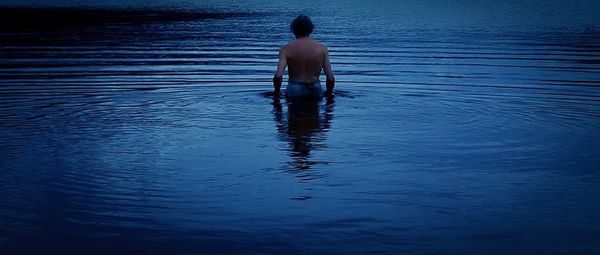Eye For Film >> Movies >> Garnet’s Gold (2014) Film Review
Garnet’s Gold
Reviewed by: Amber Wilkinson

On paper, Garnet Frost's story sounds as though it could have been culled from the pages of a tabloid - a man becomes convinced that a near-death experience in the Scottish Highlands led him to the site where Bonnie Prince Charlie's gold was hidden and, 20 years later, he decides to try to find the same spot by Loch Arkaig to discover if the treasure is there.
In practice, and thanks to some expert structuring and camerawork from debut feature director Ed Perkins - who also co-edits with Paul Carlin - the film that emerges explores not sensationalism but more familiar and interesting human sensations of loneliness, fear of failure and spirituality.

Perkins - who cut his teeth on National Geographic work and some impressive behind-the-scenes documentaries for films such as Project Nim - introduces us to Frost at close range, the camera hugging the features of his wiry, moustachioed face, shrouded in a plume of cigarette smoke that is rarely far away from this London-based fiftysomething.
"What happened to life? You lazy man," Frost admonishes himself, with a melancholy that haunts the first part of Perkins' film even though as we get to know Frost better, we realise he has been putting his artistic tendencies to good, if somewhat unfocused, use for years.
Frost lives with his elderly mum and she is as much of a character in Perkins' film as her son, offering insight into his motives - "He's capable of extraordinary things" - but also acting as an optimistic counterpoint to Frost's more contemplative air. She may be suffering ill health, but her mental vitality and love of life are strong, so that if Frost seems to find his attentions drawn to old age and lack of achievement, she talks about feeling much younger than her years.
Perkins gives Frost room to breathe, so that we get to know him and his eccentricities as he plans his trip to the north. He talks about how he loved the idea of the solitude and isolation of the Highlands, even as it becomes clear that, despite a close circle of friends, he feels an loneliness and dislocation in the crowded environs of London. The film is full of such contradictions. For example, we see him come up with an ingenious way of surveying the Highland landscape to relocate the spot from two decades past at the same time as we become aware that sometimes his spontaneity and inventiveness can quickly run out of steam or take him zipping off on an unhelpful tangent.
Frost is simultaneously a man who could spend 20 years planning a trip and yet originally went yomping off into the Highlands with nothing more than "60 Embassy No.1 and two fruit loaves". In short, he is harebrained but also magnetic.
By the time Frost heads north, Perkins has ensured we are fully invested in his quest and carefully chooses his shots to suggest an opening out of the Londoner's understanding. He replaces the close ups with wide open vistas, moving away from Garnet's face, so that we can see him as a part of the bigger landscape. The snowy and cold palette of London also gives way to the lush greens and browns of Scotland in summer spate - complete with ravenous midges. This may be the "remotest part of the remotest place on earth" but it's easy to see that Garnet feels at home here, more connected to the nature around him and, perhaps, his own nature itself.
Perkins isn't afraid to draw on classic imagery - such as the idea of baptism by immersion or conquest by climbing and thanks to measured presentation and the honesty of the ever soul-seeking Frost, he avoids manipulative pitfalls in favour of something more existentially profound. You're likely to come away considering your own place in the landscape of life and with a new-found appreciation of those who dare to dream.
Reviewed on: 07 May 2014














